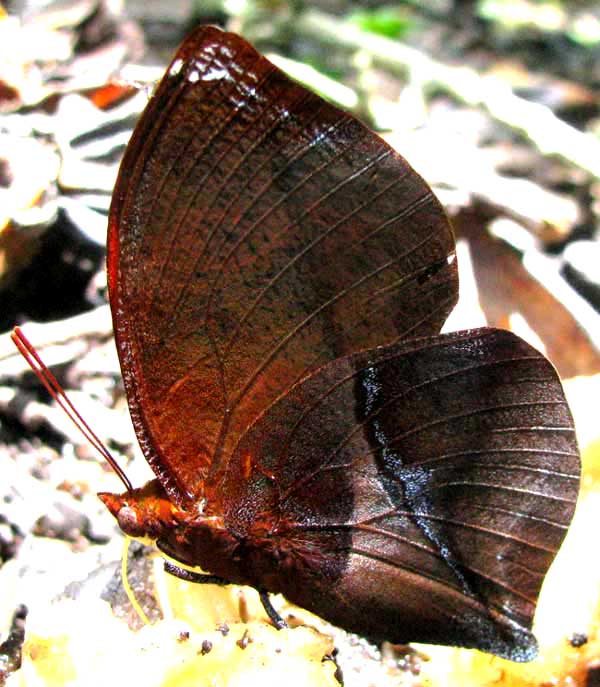Excerpts from Jim Conrad's
Naturalist Newsletter

from the July 11,, 2010 Newsletter issued from Hacienda Chichen Resort beside Chichén Itzá Ruins, central Yucatán, MÉXICO; limestone bedrock, elevation ~39m (~128ft), ~N20.676°, ~W88.569°
LEAFWING IN THE COMPOST
On Saturdays when I hike into Pisté to buy bananas as soon as I walk through the frutaría's door I know whether it'll be a good week for the butterflies who visit my compost heap. Sometimes the frutaría offers half-green bananas, and that's great, because green bananas bought that Saturday will be perfectly ripe the next Friday when I eat the last of my purchase. Usually, however, there are no green ones. I buy a lot, anyway, hoping for cool weather or maybe a miracle, so most of the time by around the next Wednesday my remaining bananas are mushy and sour. Those end up in the compost heap, and that's when it's good for the butterflies, for butterflies like nothing more than mushy bananas.
The most common compost-heap butterfly these days is the Malachite, a little like the North's yellow-and-black Tiger Swallowtail, just that its yellow is more greenish and the black more faded. You can see one at www.backyardnature.net/yucatan/malachit.htm.
This week something new turned up, the one shown above. That's the Red-striped Leafwing, SIDERONE GALANTHIS, a member of the big Brush-footed Butterfly Family, the Nymphalidae, the same family that holds the North's checkerspots, buckeyes and the like. There's a whole group, or tribe, of butterflies known as leafwings. As soon as they alight they close their wings over their backs, displaying cryptic patterns of mottled brown tones, and looking very much like brown, dried leaves. However, from time to time they nonchalantly spread their wings and then you see where the Red-striped name comes from, for the upper wing surface, in profound contrast to the lower surface, is very boldly blotched with red and black.
You can imagine how this combination of colors and patterns might benefit the butterfly. Let's say a bird is chasing the butterfly through the air, its red- flashing wings making it easy to see. Then the butterfly lands, closes its wings, and the bird, looking for its red-winged prey, overlooks the dingy, dry leaf. Also, if you're a predator on the lookout for a meal and suddenly out of nowhere a pair of red wings opens up, looking a little like a hungry mouth aimed at you, your sudden jump and moment of hesitation may be all the butterfly needs to fly away.
Red-striped Leafwings are distributed from Mexico through Central America and the Caribbean to southern Brazil, so here's another species that's emblematic of the New World Tropics. It's a favorite of visitors to the Amazon rainforest.